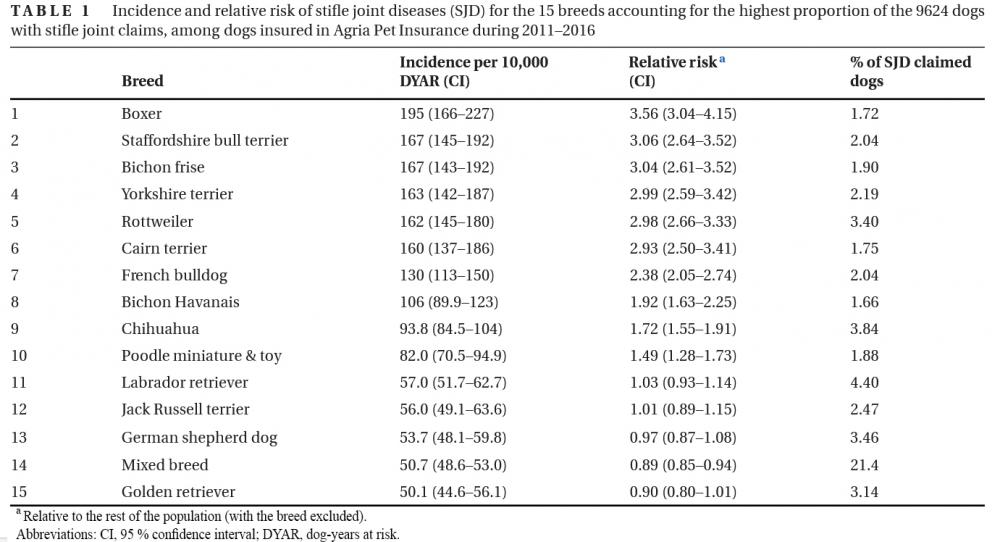The epidemiology of stifle joint disease in an insured Swedish dog population
The epidemiology of stifle joint disease in an insured Swedish dog population
Engdahl, K, Hanson, J, Bergström, A, Bonnett, B, Höglund, O, Emanuelson, U. Epidemiology of stifle joint disease in an insured Swedish dog population. Vet Rec. 2021;e197. https://doi.org/10.1002/vetr.197
Abstract
Background: Stifle joint diseases (SJD) are common in dogs and include a variety of diagnoses. The objective of the study was to provide an overview of the epidemiology of SJD in insured dogs.
Methods: An historical single cohort study of dogs insured in Agria Pet Insurance (2011–2016) in Sweden was performed. Incidence and relative risk (RR) of SJD was calculated for the whole dog population and for subgroups divided by breed, breed group and sex.
Results: The study population included almost 600,000 insured dogs (>1.7 million dog-years). Ninety-three different stifle joint diagnoses were reported in 9624 dogs, and the most common were cruciate ligament rupture and patellar luxation. The incidence of SJD was 55.4 cases per 10,000 dog-years at risk. Bulldog and boerboel had the highest RR of SJD. The breeds that accounted for the highest proportion of all SJD claimed dogs were mixed breed and Labrador retriever. Female dogs had a slightly increased RR compared with male dogs(RR1.06,p = 0.006). The incidence increased yearly during the observation period.
Conclusion: The study demonstrates breed-specific differences in incidence of SJD in dogs, which may be of importance for breeders, dog owners and veterinarians.
excerpt...
QuoteIn conclusion, SJD was common in the insured dog population. Several breeds were identified to be at high or low risk of SJD, and there was a clear distinction between the breeds that accounted for highest proportion of all SJD claimed dogs and the breeds with high- est RR of SJD. Some breeds, such as the Rottweiler and Labrador retriever, were primarily affected by CCLD, while others, such as the Chihuahua, were primarily affected by patellar luxation. Others, for example the miniature and toy poodles, Bichon frise and Yorkshire terrier, were affected by both conditions. Female dogs had increased RR compared with male dogs, and there was an increasing incidence during the study period. The demographic factors associated with SJD in the current study may guide veterinarians in their clinical work and educate dog owners about breeds at risk of disease. Further, results can be used to highlight the importance of various SJD and guide future research projects evaluating the aetiopathogenesis of these dis- eases, with the objective to identify why certain individuals are affected.
ACKNOWLEDGEMENTS
We would like to thank Agria Pet Insurance for access to the database and especially Monica Dreijer, Peter Nord Andersson and Jan Mikael Yousif for support with data access and processing. The financial support from Agria Pet Insurance is gratefully acknowledged.
Also see DWN's related content
 Donate
Donate



0 Comments
Recommended Comments
There are no comments to display.